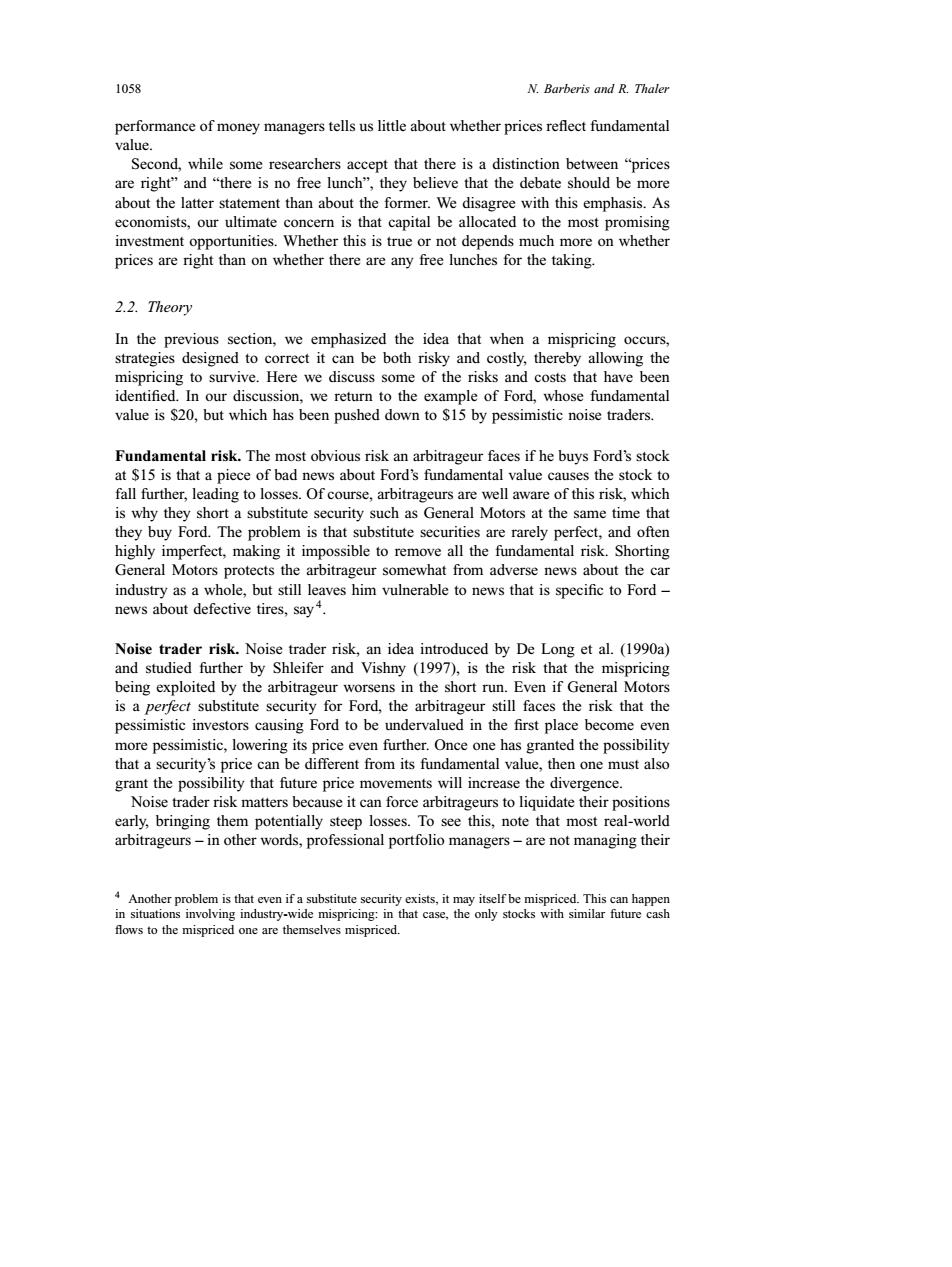正在加载图片...

1058 N.Barberis and R.Thaler performance of money managers tells us little about whether prices reflect fundamental value. Second,while some researchers accept that there is a distinction between "prices are right"and "there is no free lunch",they believe that the debate should be more about the latter statement than about the former.We disagree with this emphasis.As economists,our ultimate concern is that capital be allocated to the most promising investment opportunities.Whether this is true or not depends much more on whether prices are right than on whether there are any free lunches for the taking 2.2.Theory In the previous section,we emphasized the idea that when a mispricing occurs, strategies designed to correct it can be both risky and costly,thereby allowing the mispricing to survive.Here we discuss some of the risks and costs that have been identified.In our discussion,we return to the example of Ford,whose fundamental value is $20,but which has been pushed down to $15 by pessimistic noise traders. Fundamental risk.The most obvious risk an arbitrageur faces if he buys Ford's stock at $15 is that a piece of bad news about Ford's fundamental value causes the stock to fall further,leading to losses.Of course,arbitrageurs are well aware of this risk,which is why they short a substitute security such as General Motors at the same time that they buy Ford.The problem is that substitute securities are rarely perfect,and often highly imperfect,making it impossible to remove all the fundamental risk.Shorting General Motors protects the arbitrageur somewhat from adverse news about the car industry as a whole,but still leaves him vulnerable to news that is specific to Ford- news about defective tires,say+. Noise trader risk.Noise trader risk,an idea introduced by De Long et al.(1990a) and studied further by Shleifer and Vishny (1997),is the risk that the mispricing being exploited by the arbitrageur worsens in the short run.Even if General Motors is a perfect substitute security for Ford,the arbitrageur still faces the risk that the pessimistic investors causing Ford to be undervalued in the first place become even more pessimistic,lowering its price even further.Once one has granted the possibility that a security's price can be different from its fundamental value,then one must also grant the possibility that future price movements will increase the divergence. Noise trader risk matters because it can force arbitrageurs to liquidate their positions early,bringing them potentially steep losses.To see this,note that most real-world arbitrageurs-in other words,professional portfolio managers-are not managing their 4Another problem is that even if a substitute security exists,it may itself be mispriced.This can happen in situations involving industry-wide mispricing:in that case,the only stocks with similar future cash flows to the mispriced one are themselves mispriced.1058 N. Barberis and R. Thaler performance of money managers tells us little about whether prices reflect fundamental value. Second, while some researchers accept that there is a distinction between “prices are right” and “there is no free lunch”, they believe that the debate should be more about the latter statement than about the former. We disagree with this emphasis. As economists, our ultimate concern is that capital be allocated to the most promising investment opportunities. Whether this is true or not depends much more on whether prices are right than on whether there are any free lunches for the taking. 2.2. Theory In the previous section, we emphasized the idea that when a mispricing occurs, strategies designed to correct it can be both risky and costly, thereby allowing the mispricing to survive. Here we discuss some of the risks and costs that have been identified. In our discussion, we return to the example of Ford, whose fundamental value is $20, but which has been pushed down to $15 by pessimistic noise traders. Fundamental risk. The most obvious risk an arbitrageur faces if he buys Ford’s stock at $15 is that a piece of bad news about Ford’s fundamental value causes the stock to fall further, leading to losses. Of course, arbitrageurs are well aware of this risk, which is why they short a substitute security such as General Motors at the same time that they buy Ford. The problem is that substitute securities are rarely perfect, and often highly imperfect, making it impossible to remove all the fundamental risk. Shorting General Motors protects the arbitrageur somewhat from adverse news about the car industry as a whole, but still leaves him vulnerable to news that is specific to Ford – news about defective tires, say 4. Noise trader risk. Noise trader risk, an idea introduced by De Long et al. (1990a) and studied further by Shleifer and Vishny (1997), is the risk that the mispricing being exploited by the arbitrageur worsens in the short run. Even if General Motors is a perfect substitute security for Ford, the arbitrageur still faces the risk that the pessimistic investors causing Ford to be undervalued in the first place become even more pessimistic, lowering its price even further. Once one has granted the possibility that a security’s price can be different from its fundamental value, then one must also grant the possibility that future price movements will increase the divergence. Noise trader risk matters because it can force arbitrageurs to liquidate their positions early, bringing them potentially steep losses. To see this, note that most real-world arbitrageurs – in other words, professional portfolio managers – are not managing their 4 Another problem is that even if a substitute security exists, it may itself be mispriced. This can happen in situations involving industry-wide mispricing: in that case, the only stocks with similar future cash flows to the mispriced one are themselves mispriced